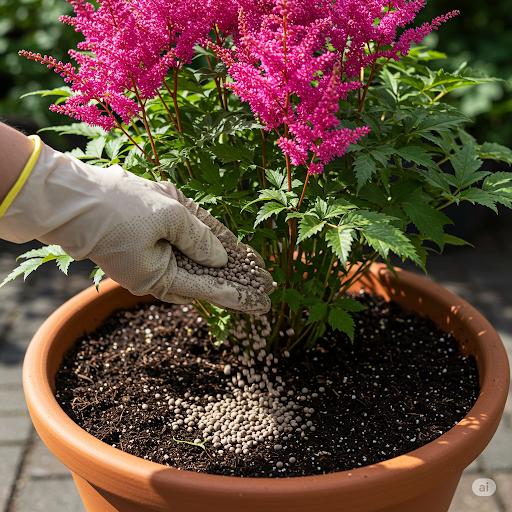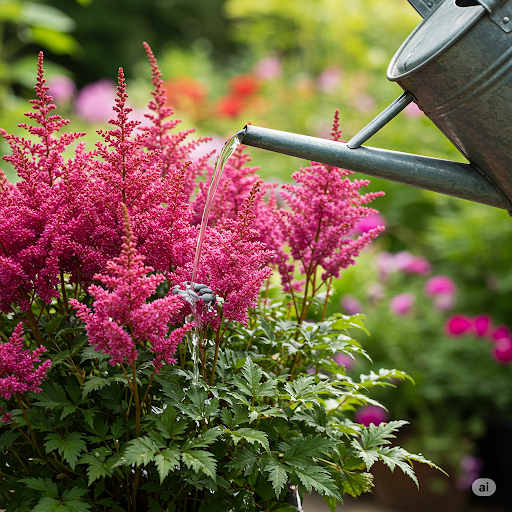Fertilizing Potted Astilbe: What Kind & How Often Do They Need Feeding?
Astilbe brings beautiful plumes of color to shady gardens, and they adapt well to container living if their needs for moisture and shade are met. One common question among container gardeners is about feeding their plants: Does potted Astilbe need fertilizer, what type is best, and how often should you apply it?
While Astilbe is not considered a heavy feeder when planted in the ground, growing any plant in a container means it has limited access to nutrients compared to a larger garden bed. Over time, the nutrients in the potting mix get used up by the plant or washed out with watering (a process called leaching). Therefore, supplemental feeding is usually necessary for the best performance of your potted Astilbe.
Does Potted Astilbe Need Fertilizer?
Yes, generally speaking, potted Astilbe will benefit significantly from regular feeding. While they might survive without it, providing nutrients will encourage stronger growth, healthier foliage, and more abundant, vibrant blooms. Think of it as providing the fuel they need to put on their best show in the limited environment of a pot.
What Type of Fertilizer Should You Use?
The best fertilizer for potted Astilbe is typically a balanced, all-purpose fertilizer. Look for a fertilizer where the three numbers (N-P-K, representing Nitrogen, Phosphorus, and Potassium) are equal or close to equal, such as 10-10-10, 20-20-20, or a slightly higher phosphorus formula (the middle number, which promotes flowering) like 10-15-10.
You have a couple of main options for fertilizer types:
- Liquid Fertilizers: These are mixed with water and provide nutrients in a form readily available to the plant. They are fast-acting but require more frequent application as they can leach out with watering. Use a water-soluble fertilizer and mix it according to the package directions, or often at half the recommended strength for container plants to avoid potential root burn.
- Slow-Release Granular Fertilizers: These come in pellet form and are mixed into the top layer of soil or the entire potting mix before planting. They are coated granules that release nutrients slowly over a period of several months (check the product label – typical durations are 3, 6, or 9 months). This provides a consistent supply of nutrients and requires less frequent application.
- Organic Options: Options like diluted fish emulsion, liquid seaweed fertilizer, or compost tea can also provide nutrients and benefit the soil microbes. Follow product directions carefully, as some organic fertilizers can have a strong odor.
Avoid fertilizers that are very high in nitrogen (the first number), as this can encourage excessive leafy growth at the expense of flowers.
How Often Should You Fertilize?
The frequency of fertilizing depends mainly on the type of fertilizer you choose:
- Liquid Fertilizers: These need to be applied more frequently, typically every 4-6 weeks throughout the growing season. Start feeding in spring as new growth emerges and continue until late summer (around August). Stop fertilizing in the fall to allow the plant to prepare for dormancy.
- Slow-Release Granular Fertilizers: These are usually applied only once at the beginning of the growing season (in spring) according to the product's instructions. The fertilizer will then continue to feed the plant over the period stated on the packaging. If using a long-lasting formula (e.g., 6-9 month), one application might be sufficient for the entire season.
Always read and follow the instructions on the specific fertilizer product you purchase, as concentrations and release rates can vary.
Tips for Fertilizing Potted Astilbe
- Water Before Fertilizing: If using liquid fertilizer, water the plant thoroughly with plain water beforeapplying the fertilizer solution. Applying fertilizer to dry soil can burn the roots.
- Don't Over-Fertilize: More is not better! Applying too much fertilizer can damage roots and harm the plant. Stick to the recommended dosages.
- Timing is Key: Fertilize during the plant's active growth period (spring and summer). Stop feeding as temperatures cool in late summer or early fall.
- Check Potting Mix: If you are using a high-quality potting mix fresh out of the bag, it often contains a slow-release fertilizer already. Check the bag description. If it does, you may not need to fertilize for the first few months.
By providing your potted Astilbe with a balanced fertilizer during the growing season, you'll support healthy foliage and ensure they have the energy needed to produce their beautiful, fluffy flower plumes.


Comments
Post a Comment